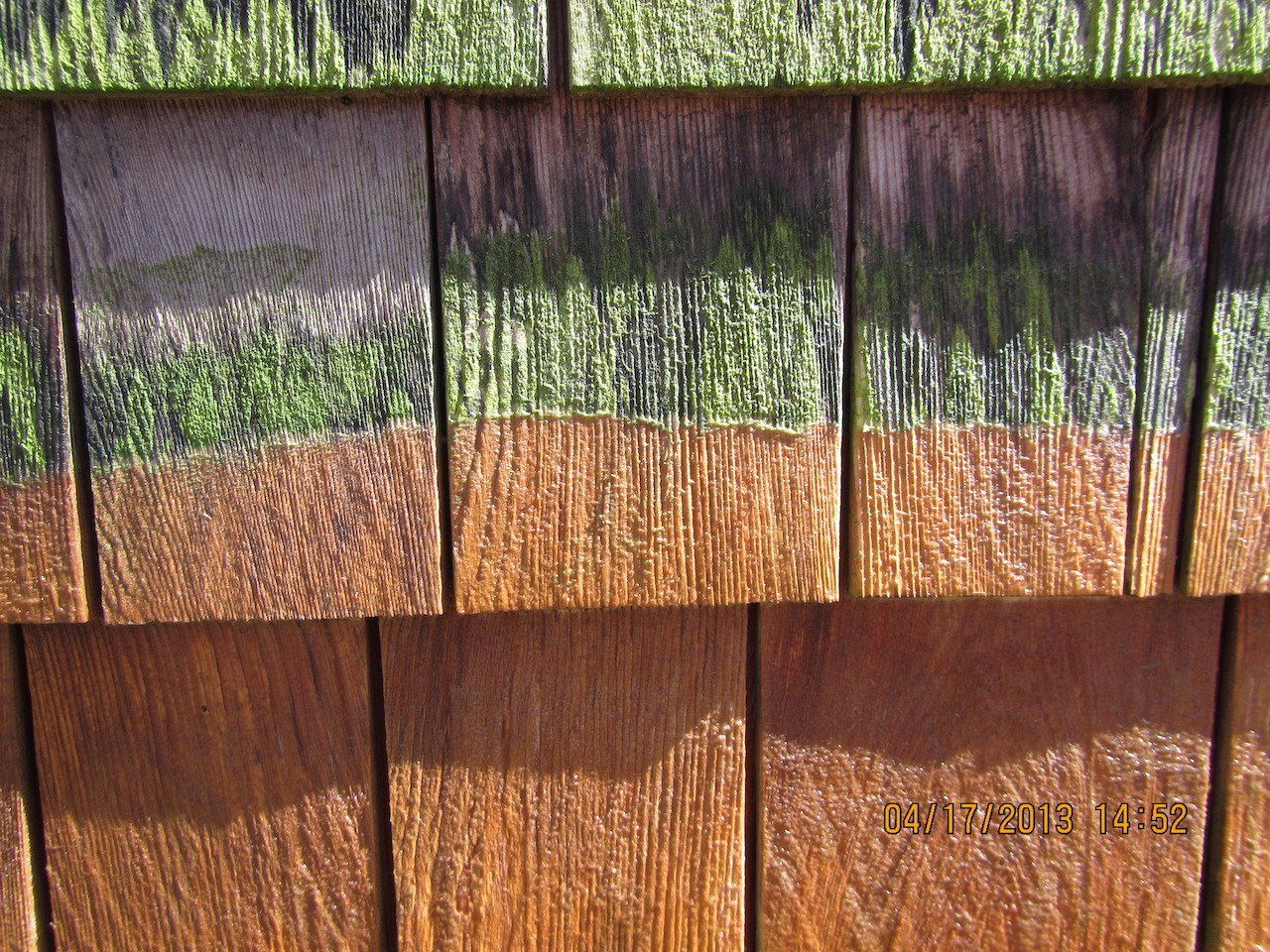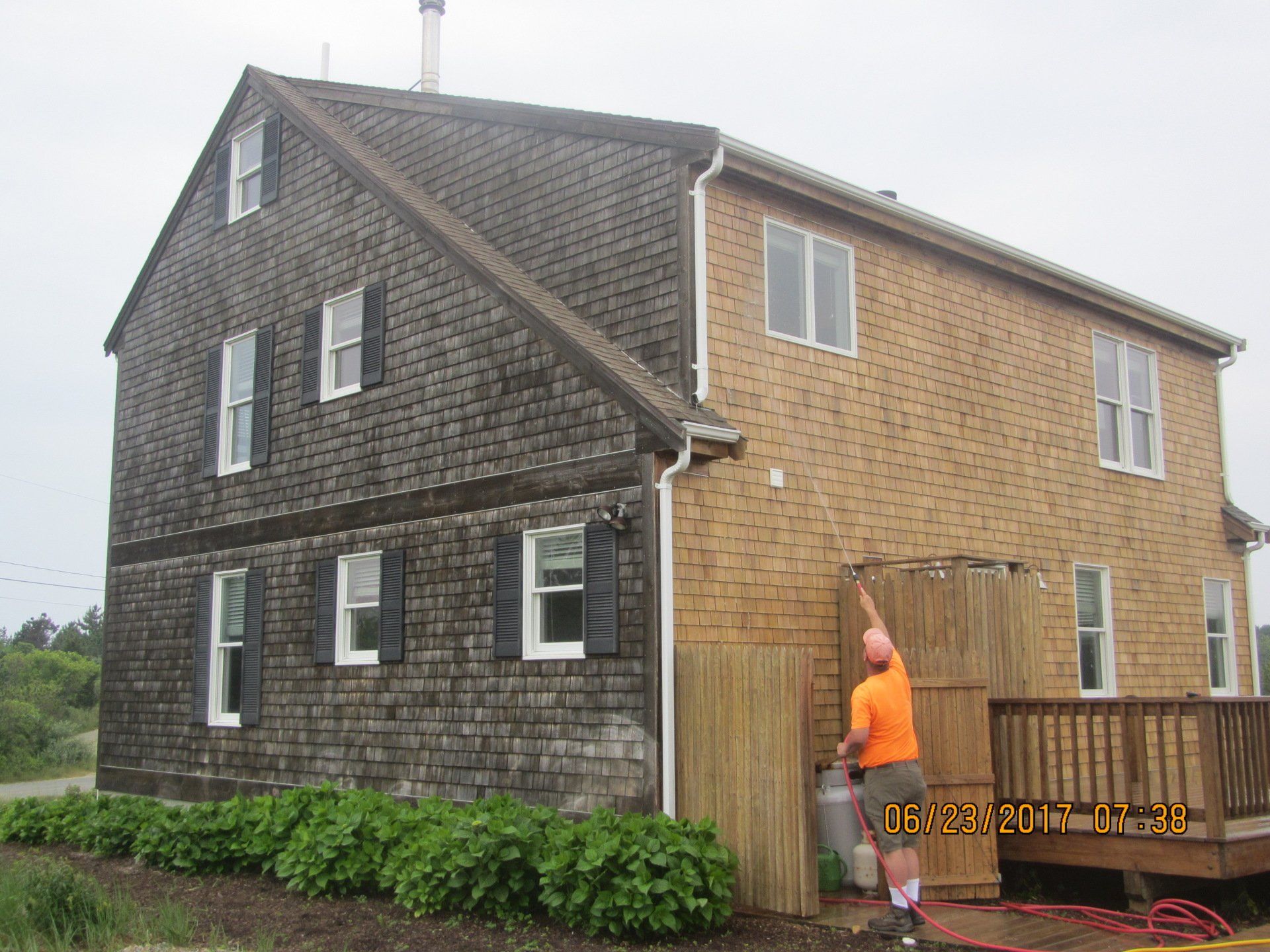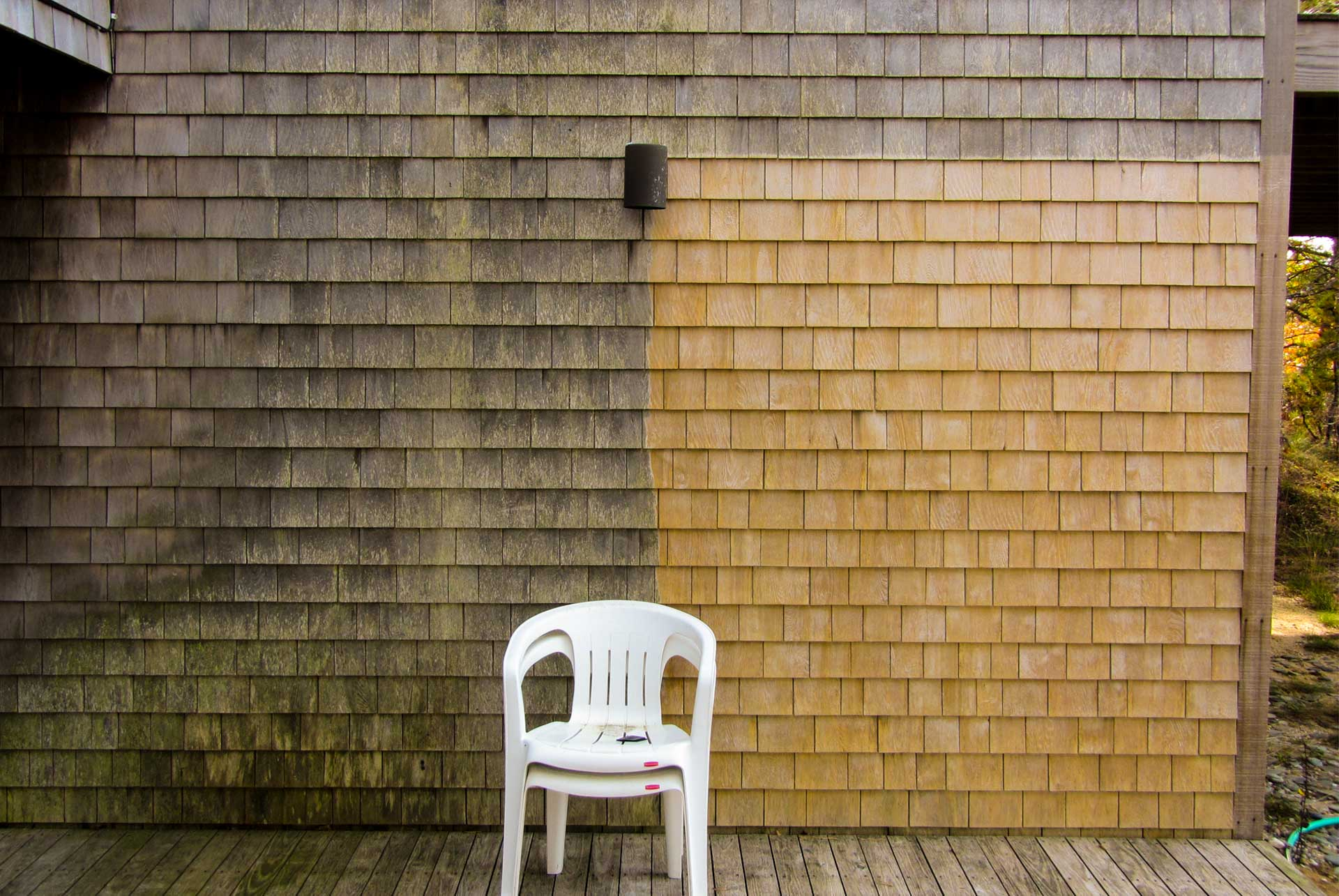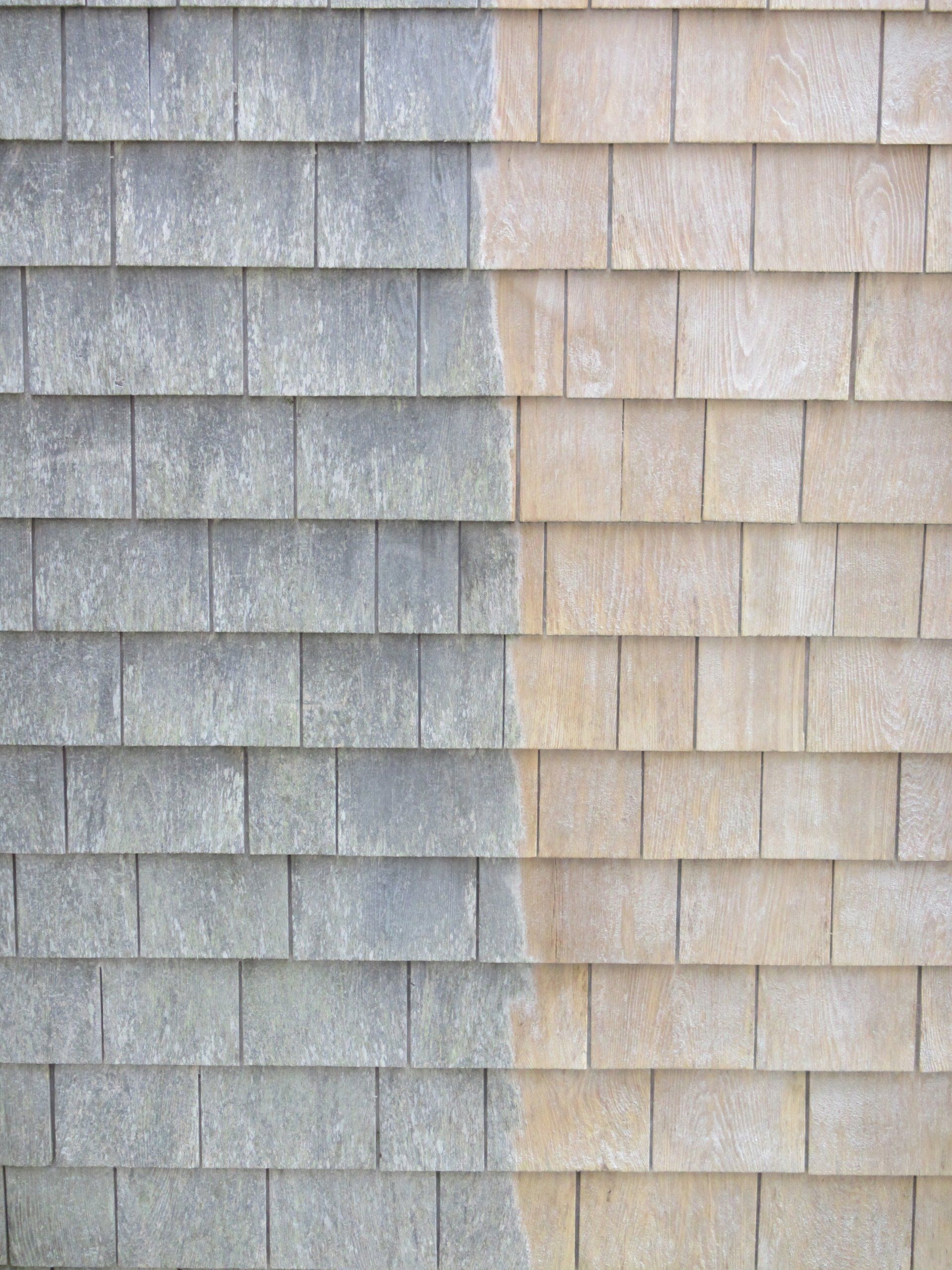New Paragraph
Cedar Shingled Siding
Nothing says "Cape Cod" like a house with cedar shingled siding. Cedar shingled siding is
the timeless, historic look of Cape Cod seaside properties.
As the quality of available cedar has
generally gone down, and certain environmental factors have changed, cedar siding is increasingly afflicted with organic growth and environmental pollutants. These factors can contribute to poor appearance of cedar siding shingles. Washing a building's cedar shingled siding is a popular way to make it look years younger, and to potentially add years to the siding's service life.
Experience tells us that there is no single "best" way to clean every type of siding in every type of condition, and so we offer many cleaning methods to help best address YOUR property's unique needs and situation.
We routinely wash cedar sidewall shingles. Contact us today for a consult.
"HOW do you clean cedar siding shingles?"
It depends upon their condition. There is no "one-size-fits-all" solution! Siding which is fairly new generally doesn't warrant the same cleaning as siding which is 20+ year old. For that reason, we have all cleaning methods at our disposal.
No method is appropriate for
all situations! Each has pros and cons.
"Can ALL cedar shingles be cleaned?"
No! Some cedar shingles are just "too far gone." When that's the case, we won't offer to do anything because any attempts at cleaning them will ultimately just be a waste of your money. For this reason, we turn away more than 30% of the cedar jobs we are called to look at.
"Explain power washing
and soft washing."
As the name implies, power washing (or "pressure washing") tends to rely upon pressure to clean a surface. Soft washing relies more upon chemicals. The best washing method depends upon the details of the job.
When a home has only some mild mold and mildew on it's exterior, it is often a good candidate to be soft washed. However, the presence of algae, moss, and lichen can require a more comprehensive cleaning process in order to get your siding meaningfully cleaned and to keep it that way for as long as possible. For that reason, we offer BOTH power washing and soft washing. Regardless of who offers these cleaning methods, neither are perfect and both have pros and cons to be considered.
There's lots of confusion and deceptive advertising regarding this topic, and so I've made a video to help illustrate the issues:
"So why not just 'Soft Wash'
everything? "
When a home has only some mild mold and mildew on its exterior, it is often a good candidate to be "soft washed." However, the presence of galvanized sidewall nails can
complicate the use of strong cleaning chemicals used in soft washing. Furthermore, the presence of algae, moss, and lichen can require a more comprehensive cleaning process in order to get your siding meaningfully cleaned and to keep it that way for as long as possible. That's why we regularly power wash cedar siding here on Cape Cod.
"So does my house need Soft Washing or Power Washing? "
We'll be the judge of that. It depends upon the condition of your sidewall shingles, and what's growing on them! We'll take a look and give you our recommendation in writing.
"How MUCH pressure does power washing use?"
"My neighbor ruined his siding with a power washer... "
Yeah... because he didn't know what he was doing! Your neighbor lacked the necessary experience, tools, and cleaning chemicals. But he
did have enthusiasm!
In the right hands, a power washer can help make quick work of large cleaning jobs. In the WRONG hands, it can permanently damage your property.
So can the
very strong
chemicals used in
"soft washing".
Most homeowners and non-professionals attempt to clean decks with pressure alone, bypassing the most important step: application of an appropriate cleaning solution. The correct cleaning solution for the job will loosen surface contaminants such as mold, dirt, and algae, allowing it to be rinsed away with safely low pressure.
Additionally, "homeowner"-grade power washers provide far too low of a flow rate (GPM) to rinse cedar shingled siding in a timely manner. Our commercial cleaning equipment provides many times the flow rate of typical homeowner-grade power washers, allowing us to rinse with volume rather than pressure.
As for the matter of experience, rest assured that Nate has 10,000+ hours of experience with power washing wooden surfaces here on Cape Cod. We do not "sub out" this work or assign it to a pool of inexperienced, un-trained, or otherwise interchangeably short-term employees; Nate does the powerwashing.
New construction: "Should I stain my cedar siding or leave it natural?"
Good question. There's pros and cons to both. In general, staining will require more maintenance over the years, but will look better for longer. I do NOT recommend anything other than a solid stain (i.e. othing transparent, translucent, etc). Here's why:
Can you clean our siding before it is re-stained?
Yes. Before the paint, stain, or primer is applied, the quality and longevity of your project will depend greatly upon how well the surfaces are cleaned. With that in mind, remember that cleaning is
ALL we do!
Can we just "soft wash" my cedar shingled before re-staining it?
No. "Soft washing" is superficial. If you're prepping your shingled cedar siding for stain (or re-stain), you want it cleaned as thoroughly as possible. Like washing dirty hands, that requires the right soaps and rinsing pressure.
Don't believe me? Here's an example of the messes we encounter:
Our siding has "bleaching oil" and it looks just horrible...
Unfortunately, that's a common tale! Once a credible product,
"bleaching oil" has changed formulation many times over the years, even as the name remained the same. Builders offered it as a way to get the "weathered" look without having to wait for siding to weather naturally. Unfortunately, since the early 2000's, the shingle treatment has attracted far more than it's fair share of mold and mildew.
Because the formulation of "bleaching oil" has changed over the years, there is not a "one size fits all" solution to every bleaching oil problem. Give us a call, we'll take a look and explain your options.
"My natural cedar shingled siding is practically BLACK!"
Here on Cape Cod, the natural cedar shingled siding on the south and west sides of our buildings generally turn dark - or even black - as years go by. Many homeowners find this to be unsightly. Although this siding can't be made to look Brand New again, it can usually be made to look much better.
"My cedar siding has little holes in it...."
Might be carpenter bees, which we commonly encounter here on Cape Cod. Before you reach for the caulk gun, keep in mind that there's an easy, way to address this chemical-free was to address carpenter bees: carpenter bee traps:
"I have an unnatural level of interest in all things cedar...."
You're in luck! So does Nate. Here's a link to much more info. Enjoy the rabbit hole.
Allrighty then! Can you take a look at my siding?
Kindly contact us by phone, e-mail, or our online contact form . We'll take a look at the job and e-mail you a written work proposal. It's that easy.



